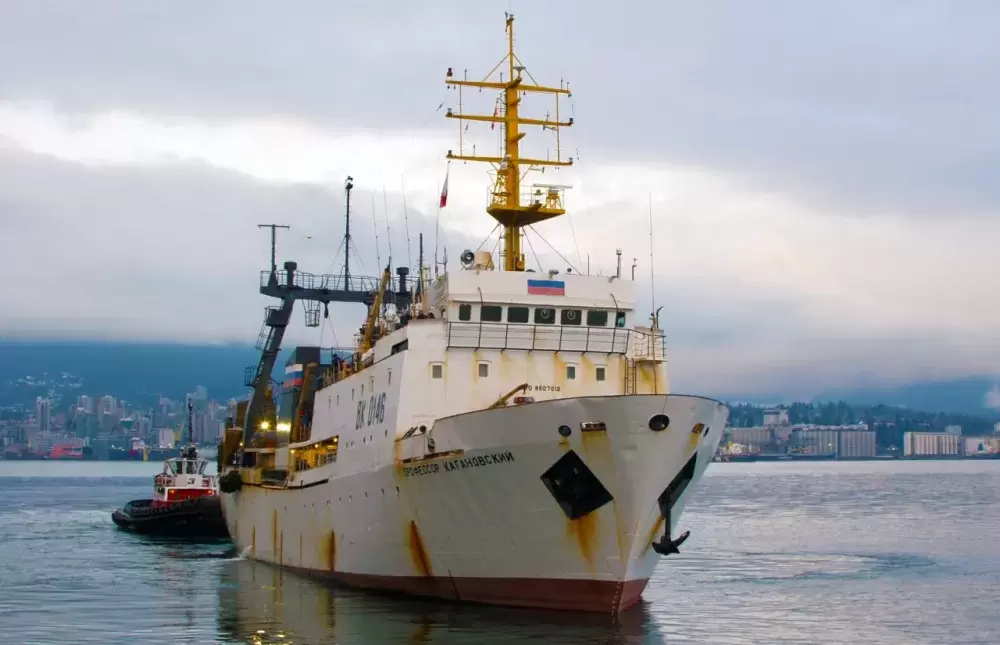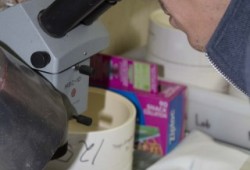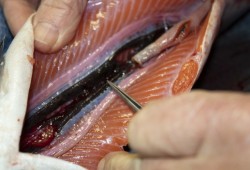An international research team probing deeper into the mystery of Pacific salmon survival during ocean migration has made some surprising discoveries, says Dick Beamish, expedition organizer.
The International Gulf of Alaska Expedition departed Vancouver in mid-February with a team of 21 scientists from five salmon-producing countries.
Beamish, emeritus scientist with the Pacific Biological Station in Nanaimo, said he believes the deep-sea research can answer key questions about the steady decline of some B.C. salmon populations since the 1950s.
“A precipitous decline is obvious, and the issue here is marine survival,” Beamish said. “We basically do not understand the mechanisms that regulate marine survival.”
He described the offshore research as potentially ground-breaking, a signature event during International Year of the Salmon (IYS).
“We are, for the first time, studying salmon survival in the Gulf of Alaska at the end of their first ocean winter,” he said. “This has really never been done before. We’ve studied marine survival in near-shore areas, starting in the mid-90s in North America. The Russians have been doing it since the mid-80s.”
Over a few glasses of vodka in Vancouver and St. Petersburg, the retired Canadian scientist secured the services of the Russian research vessel Professor Kaganovsky with a crew experienced in the notoriously rough seas of the gulf in winter. Living conditions are crude aboard the 1970 trawler but Beamish is confident he got “the best ship and the best crew” for the job. A heart condition prevented him from joining the rigorous voyage, but he has tracked its progress from his Vancouver Island home.
Biologists have long thought that faster juvenile salmon growth in the early marine period increases their likelihood of survival at sea. The research — sampling for diseases, diet, size and health as well as for genetic signatures for origins — will attempt to test the hypothesis of survival mechanisms.
“We’ve already made some discoveries,” Beamish said. “There are surprises. What we’ve seen in about 10 days is that we’re not catching as many fish as expected. They’re in areas where I thought the catches would be larger. Now if we get 50 salmon, it’s a very good catch. We’re catching coho way offshore and we’re seeing sockeye in areas where we hadn’t expected them.”
They also said they conducted the first DNA identification ever while at sea.
Against the backdrop of climate change and its effects on the marine environment, the scientists hope to find ways of determining stock status more accurately. This could improve management of stocks as they fluctuate widely and inexplicably.
“We are concerned because we’ve seen stocks in low abundance for so long,” Beamish said. “Why is Russia getting historically high catches of pink? It all relates to the need to understand how the mechanisms work.”
Why did it take so long to mount such a project when some wild salmon populations, specifically chinook, have been in decline for decades? Research to date has concentrated on near-shore areas.
“This has never been done before because it’s not easy to sample in the Gulf of Alaska in the middle of winter,” Beamish said. “[The Russians] have a proven ability to do these surveys and establish abundance.”
The idea emerged at a Vancouver workshop several years ago, he said. He wanted to set up a research project with the goal of advancing the science in a revolutionary way. Funding was cobbled together from a variety of sources, $1.3 million in donations from governments, industry, non-governmental organizations and private donors.
“I wanted to do something different,” said Beamish. “The point is this: Sometimes it’s easier for government to join the parade than it is for government to lead the parade.”
Jim Lane, southern region biologist with the NTC’s Uu-a-thluk, was reluctant to comment without more detail, but said the timing of the research makes it interesting. Marine survival data is already available, yet biologists don’t have data two years into the four-year life cycle.
“We know there’s a pretty good correlation between [water] temperature and marine survival,” Lane noted.
Marine survival of most West Coast salmon dropped drastically in 2014-2015 in relation to ocean temperatures. How ocean conditions affect marine survival is yet to be determined, Lane said.
Conclusive studies would take a number of years, not weeks, Lane added. Beamish is expecting the deep-sea research will continue.
“I’m convinced our results will be sufficiently important that this will all be repeated,” he said, suggesting the high-seas research will continue beyond the expedition.
While there is no direct First Nation participation in the expedition, Beamish said the research is integral to Indigenous interests.
“I can assure you that Indigenous concern about future stewardship of salmon is a strong inspiration,” he said.
IYS is a partnership between the North Pacific Anadromous Fisheries Commission, the North Atlantic Salmon Conservation Organization and NGOs, including the B.C.-based Pacific Salmon Foundation. Their goal is to establish a new hemispheric-scale partnership, including Indigenous peoples, in a common effort “to address the scientific and social challenges facing salmon and people in an increasingly uncertain environment.”










